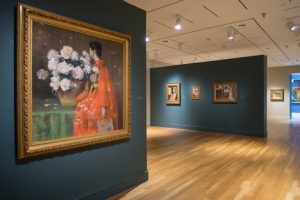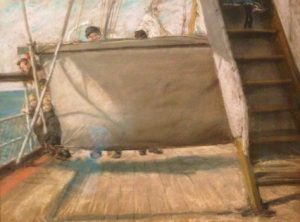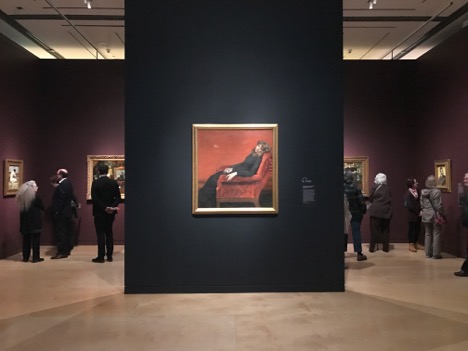William Merritt Chase: A Modern Master
Curated by: Katherine M. Bourguignon, Giovanna Ginex, Erica E. Hirshler, and Elsa Smithgall
Exhibition schedule: The Phillips Collection, Washington, DC, June 4–September 11, 2016; Museum of Fine Arts, Boston, October 9, 2016–January 16, 2017; Ca’ Pesaro Galleria Internazionale d’Arte Moderna, Venice, February 11–May 28, 2017
Exhibition catalogue: Elsa Smithgall, Erica E. Hirshler, Katherine M. Bourguignon, Giovanna Ginex, and John Davis, William Merritt Chase: A Modern Master, exh. cat. New Haven: Yale University Press in association with The Phillips Collection, 2016. 248 pp.; 176 color illus. Hardcover $60.00 (ISBN: 9780300206265)
William Merritt Chase: A Modern Master surveys the long career of one of the most virtuosic painters of the late nineteenth century. Renowned during his lifetime, Chase (1849–1916) is perhaps best known today as an influential teacher to such artists as George Bellows, Edward Hopper, Georgia O’Keeffe, and Charles Sheeler—students who would ultimately overshadow their mentor’s career and legacy. After his death a century ago, Chase’s notability began to wane with the arrival of more overtly modernist styles. As the opening panel at the Museum of Fine Arts, Boston read: “William Merritt Chase is the most famous nineteenth-century American painter of whom many people have never heard.”1
A cooperative effort between The Phillips Collection, Washington, DC, the Museum of Fine Arts, Boston; the Fondazione Musei Civici di Venezia; and the Terra Foundation for American Art, A Modern Master brings Chase back into the spotlight. Emphasizing his breadth, the exhibition plumbs every dimension of Chase’s oeuvre and artistic persona. Well-traveled and the product of international artistic training, Chase was eclectic in every sense; this extended to his personal style, the artists who influenced him, and the various media he embraced. Born in Indiana, Chase received academic training at the National Academy of Design in New York. Then, in 1872, he ventured to Munich, where he studied at the Royal Academy for six years before accepting a teaching position at the Art Students League in New York. Thereafter Chase returned frequently to Europe with colleagues and students, studying the work of the Old Masters and visiting the studios of contemporary painters in artistic epicenters, such as Paris and London, as well as Belgium, the Netherlands, Italy, and Spain.
Chase’s declaration, “My God, I’d rather go to Europe than to Heaven!” set the tone for the retrospective of an artist who straddled the Atlantic. The exhibition and its accompanying catalogue demonstrate a dedication to considering Chase in an international context, but what is especially useful is their complication of the French-American exchange that most discussions of American Impressionism tend to invite. While acknowledging that Paris exerted enormous influence on Chase, the exhibition emphasizes the numerous and distinct inspirations absorbed by the artist from other regions of the continent. A Modern Master paints a truly cosmopolitan portrait of Chase, who bounced among, and borrowed from, a host of European artistic traditions.
The two venues in the United States—The Phillips Collection and the Museum of Fine Arts, Boston—took different approaches to the installation of Chase’s work, but both effectively demonstrated his stylistic and material virtuosity.2 The exhibitions included roughly ninety portraits, still lifes, genre scenes, landscapes, and, most notably, Chase’s large-scale pastels. The Phillips used a chronological organization, while the MFA, Boston, employed a more thematic approach. Both exhibitions, however, abundantly demonstrated Chase’s penchant for melding the historical with the contemporary. For instance, he frequently alluded to Old Masters including Frans Hals, Anthony van Dyck, and Diego Velázquez in his compositions, but often updated these artistic references through the use of bravura brushwork or subdued tonal washes. These eclectic composites of old and new, coupled with a breadth of subject matter and stylistic experimentation, make the “Modern Master” moniker well earned.
Nowhere is Chase’s eclecticism on greater display than in his famous Tenth Street Studio paintings, which welcomed visitors early on at both The Phillips and MFA, Boston. These pictures, which present dense groupings of diverse bric-a-brac, textiles, furniture, and art, demonstrated Chase’s cosmopolitanism and bolstered his reputation with critics, patrons, and the public.3 With the studio serving as a site of theatricality and artistic creation, the paintings were exercises in artifice. Chase, ever the performer, held painting demonstrations for students and patrons in his studio among his carefully curated objects. As some of Chase’s best-known works, they continue to function as the promotional pictures they were intended to be.
A highly sought-after portraitist, the grand likenesses of society folk, close friends, and family by Chase populated several galleries. His wife, Alice, along with their eight children, appeared throughout the exhibition, occupying landscapes and domestic scenes, as well as serving as the subjects of numerous portraits. Chase frequently adapted Old Master tropes of male portraiture when depicting his female sitters, resulting in evocative depictions of “new women,” a distinctly American subject.4 Chase’s modern thinking extended to his portraits and to his mentoring of female students, a theme drawn out in the exhibitions as well as the catalogue. Proclaiming that “Genius has no sex,” Chase advised male and female students equally and actively collected art by women at a time when this was not the norm.
The monumental Portrait of Dora Wheeler (1882–83; Cleveland Museum of Art), featuring Chase’s first student, was granted its own wall for both American venues. When it was first exhibited in the 1880s, Wheeler’s pensive look captivated some viewers, while the painting’s bold palette agitated others.5 Again, Chase gestured to the Old Masters, and Hals in particular, but he also nodded to his contemporary James McNeill Whistler’s famous portrait of the artist’s mother (1871; Musée d’Orsay). Chase’s infamous portrait of Whistler (1885; The Metropolitan Museum of Art) was positioned next to Dora Wheeler at the first two venues of A Modern Master, further emphasizing their affinity. Stylistic exchange with contemporaries like Whistler and John Singer Sargent are evident throughout the exhibition. Discerning visitors to the MFA, Boston, likely made a connection between the scenes of girlhood in the dark interiors of Chase’s Hide and Seek (1888; The Phillips Collection) and Sargent’s Daughters of Edward Darley Boit (1882; Museum of Fine Arts, Boston), stationed a floor above.

In addition to celebrating his oil paintings, A Modern Master brings attention to Chase’s exceptionally ambitious pastels, the production of which distinguished him from his contemporaries. After viewing the pastels of Giovanni Boldini in his Paris studio, along with those of other artists in Venice, Chase cofounded the Society of Painters in Pastel in 1883. Chase and the members of the Society considered pastel a medium on par with oil, and by hanging Chase’s pastels among his oil paintings, The Phillips and MFA, Boston literalized this notion. One of the standouts, the monumental pastel Spring Flowers (Peonies) (c. 1889; 45 x 45 in., Terra Foundation), rivals the size of Chase’s full length portraits— a rare feat for such a delicate medium (fig. 1). Pastel afforded new avenues of experimentation for Chase, which often emerged as texture studies: the reflective and sumptuous surfaces of the work on display exhibits Chase’s command of the medium.
In Spring Flowers (Peonies), as in many other pictures, Chase included a costumed sitter and Eastern props, in line with the Western infatuation with Japanese culture during the late nineteenth century. While both American exhibitions articulated the influence of Japanese art in the West and noted the emergence of japonisme, the MFA, Boston, went further by directly addressing the inherent imperialism of this appropriation in pointed wall text. Given that Chase traveled extensively in Europe and never visited Asia, this critical, albeit brief, intervention was important. Nearby, the museum also provided an example of a book of Japanese prints similar to the one depicted in pastels Hall at Shinnecock and Shinnecock Studio Interior (both 1892; Terra Foundation) for comparative study. By pointing to the orientalist elements of Chase’s pictures, while also situating them in their historical moment, the MFA, Boston, enabled visitors to enjoy the artwork, while maintaining an appropriately critical perspective of japonisme (and eclecticism) more broadly.

The bulk of Chase’s work depicts lifestyles and likenesses of the bourgeoisie, but class division comes to the fore in one of Chase’s smaller and lesser-known pastels sketched on a return voyage from Europe (fig. 2). Featured only at The Phillips Collection, The Dividing Line (1883; private collection) shows a crowd of steerage passengers on a ship peering into the foreground from behind a hanging sail. Meanwhile, a well-heeled woman, recognizable by a petite shoe and the fringe of an elegant dress, ascends stairs to the upper deck, on the viewer’s side of the divide. Utilizing angular diagonals and a palette dominated by ruddy earth tones, Chase allowed the toothy brown drafting paper to show through. The large swathe of sail fabric, like a blank canvas, is reflected back at Chase (and the viewer) who occupies the side of the upper class passengers, marked by mobility and literal ascendancy. Modern in its geometric composition and perhaps in its meta-meditation on artistic media, the social distinctions explored in The Dividing Line predate the grit of the Ashcan School and The Steerage (1907; 1913) by Alfred Stieglitz. Included in a gallery with scenes of well-dressed people lounging outdoors and artfully appointed Shinnecock studio interiors, The Dividing Line reveals an element of social awareness not often expressed in Chase’s work and adds a dash of self-consciousness to the gentleman-painter persona he projected.
That Chase moved between modestly-sized sketchy scenes produced aboard a ship and large-scale studio renderings of metallic sheens, iridescent silks, and fleshy skin tones demonstrates his aptitude for manipulating pastel and his dedication to elevating the medium. To hang the pastels alongside oil paintings was to perform that elevation, but it also enabled a side-by-side comparison of Chase’s mark making. Chase’s rough and visible brushstrokes (in Dora Wheeler, for example) resemble strikes of chalk, while the velvety tones in many of his oil portraits (such as those in the Whistler likeness) evoke gently blended powdery pigment. For all of Chase’s bold experimentation in the medium, the pastel movement of the nineteenth century was, after all, a revival.6 Once again, Chase’s modern take emerges from a reverence for the past. Owing to the careful work of conservators, many pastels hitherto unable to travel made their way across the country to Washington and Boston. Unfortunately, given their fragility, the pastels did not travel to the venue in Venice.
From the gentle breeze of a cliff walk to the cozy confines of a studio interior, and from distinguished portraits to close studies of eviscerated fish, Chase’s subjects run the gamut. For visitors unfamiliar with his work, A Modern Master is a comprehensive introduction. For those acquainted with Chase, the variety and breadth of the work on view serves as a reminder of his virtuosity. Chase’s eclecticism offers something for everyone. With such a variety of subject matter, it takes a moment to notice the absence of urban New York, industrial London, or electrified Paris. We see the Tenth Street Studio’s impeccably arranged interior, evocative of old European ateliers, but never its exterior or the surrounding area of lower Manhattan. Chase loved painting en plein air, but only among the hills in Shinnecock, the shores of Holland, or the canals of Venice. If Chase painted in the city, it was in a pristinely manicured park. Chase was openly critical of industrialization and its negative impact on artistic production and modern life. He erased any hint of this encroaching influence in his work, choosing only antique, exotic, or handcrafted items for his interior scenes.7

Chase’s fraught relationship with modernity and admiration for the painters of yore is tempered by an unabashed embrace of flatness and paint as paint (or pastel as pastel). The aptly chosen face of the exhibition, The Young Orphan (1884; National Academy Museum, New York) speaks directly to the dialectic of Chase’s modern mastery (fig. 3). Titled Portrait when first exhibited in Belgium, fields of red surround a young woman as she reclines in an armchair barely distinguishable from the background.8 A simple black dress engulfs her and cuts diagonally across the picture plane. The ever-present coarse weave of the canvas absorbed Chase’s thin washes of paint, resulting in a blurred image. It is as though we, the viewers, are looking at the sitter through tearful eyes—a believable viewpoint after the painting’s title became The Young Orphan when it was exhibited in the United States some months later. With its conspicuous materiality and visual abstraction, The Young Orphan showcases Chase’s modernist tendencies, but the narrative-centric retitling yokes it to Victorian sentimentality.
Both American venues followed Chase into the twentieth century, including highlights from his later years, such as his final painting Self Portrait in 4th Avenue Studio (1915–16; Richmond Art Museum). This life-sized rendering of the artist, with an unfinished canvas bearing abstract wisps of paint, seems to foreshadow the modernism that many of his students would cultivate. In fact, The Phillips included a small gallery, set off from the main exhibition, with a cluster of works from their collection by Chase’s more notable students, many of whom would later be collected by Stieglitz. (Regrettably, Chase’s nearly monochromatic 1905 portrait of Stieglitz, in the collection of the Beinecke Library at Yale University, was not included in the exhibition; this was a missed opportunity to explore their friendship and further emphasize Chase’s contribution to American modernism.) The MFA, Boston, linked A Modern Master with their recently reinstalled permanent galleries by placing special labels near works by Chase’s students. This resulted in a spatial demonstration of Chase’s diffused influence on modern American art.
Each iteration of A Modern Master embraced facets of Chase himself. With its chronological organization, supplementary cases of instructive technical and archival material (e.g., a family photograph album, tools for working pastel such as stumps and cuttlebone), and intimate galleries that urged careful study, Chase’s legacy as a teacher felt omnipresent at The Phillips. In line with this academic bent, The Phillips hosted a public symposium with two of the exhibition curators Elsa Smithgall and Erica Hirshler, John Davis of the Terra Foundation, and art historians Isabel Taube and Fred Baker. The MFA, Boston, maintained this level of intellectual rigor (especially in its address of japonisme and imperialism), while capitalizing on the benefits of its monumental exhibition space. The installation at the museum employed dramatic color schemes, thematic organization, and theatrical undertones, which seemed to take their cue from Chase’s flamboyant public persona. Bracketed by studio scenes and bedecked in reproduction drapery, visitors explored Chase’s oeuvre in the same way as the patrons and students who frequented his New York atelier. In fact, visitors had the opportunity to sit in a two-dimensional enlargement of Studio Interior (c. 1882; Brooklyn Museum), resulting in a photo opportunity ripe for sharing on social media. In Boston, Chase truly dazzled, and these creative extras yielded the kind of buzz that Chase was accustomed to in his day. Lastly, Venice, the site of frequent study trips, summer classes, and international biennials, served as the European outpost and final destination of the exhibition. In essence, it enabled viewers to consider Chase’s work within the international context from which it often emerged. Housed in Ca’ Pesaro, the seventeenth-century palazzo turned modern art museum, Chase’s work found a temporary home in this fittingly eclectic space.
Ultimately, the exhibition underscores how Chase synthesized diverse influences while revealing the virtuosity that set him apart from his peers and predecessors. In his portraits, landscapes, interiors, and still lifes, Chase effortlessly combined historical tropes with contemporary subjects, often infusing them with prescient abstractions. The epithet “Modern Master” encapsulates the paradox of an experimental painter with nostalgia for a bygone era in his brush.
DOI: https://doi.org/10.24926/24716839.1599
PDF: Michelon – WM Chase – A Modern Master
Notes
- Wall text for William Merritt Chase: A Modern Master. October 9, 2016–January 16, 2017, Museum of Fine Arts, Boston. ↵
- Some works appear in one show but not the others due to loan restrictions. ↵
- For more on Chase’s eclectic studio pictures, see Isabel Taube’s recent article: “William Merritt Chase’s Cosmopolitan Eclecticism,” Nineteenth Century Art Worldwide 15.3 (Autumn 2016), http://www.19thc-artworldwide.org/index.php/autumn16/taube-on-william-merritt-chase-cosmopolitan-eclecticism. ↵
- See Erica Hirshler, “Old Masters Meet New Women,” in William Merritt Chase: A Modern Master, 17–29. ↵
- See John Davis, “William Merritt Chase’s International Style,” in William Merritt Chase: A Modern Master, 47–61. ↵
- The medium was especially popular for portraiture in eighteenth-century France. ↵
- Taube, “William Merritt Chase’s Cosmopolitan Eclecticism.” ↵
- See Davis, William Merritt Chase: A Modern Master, 54–57, for more about The Young Orphan’s reception in Belgium and the “battle of the reds” that occurred when Sargent’s Dr. Pozzi at Home, (1881; The Armand Hammer Collection) was placed directly opposite it on display. ↵
About the Author(s): Christina Michelon is a doctoral candidate in art history at the University of Minnesota.

